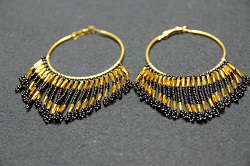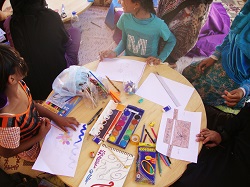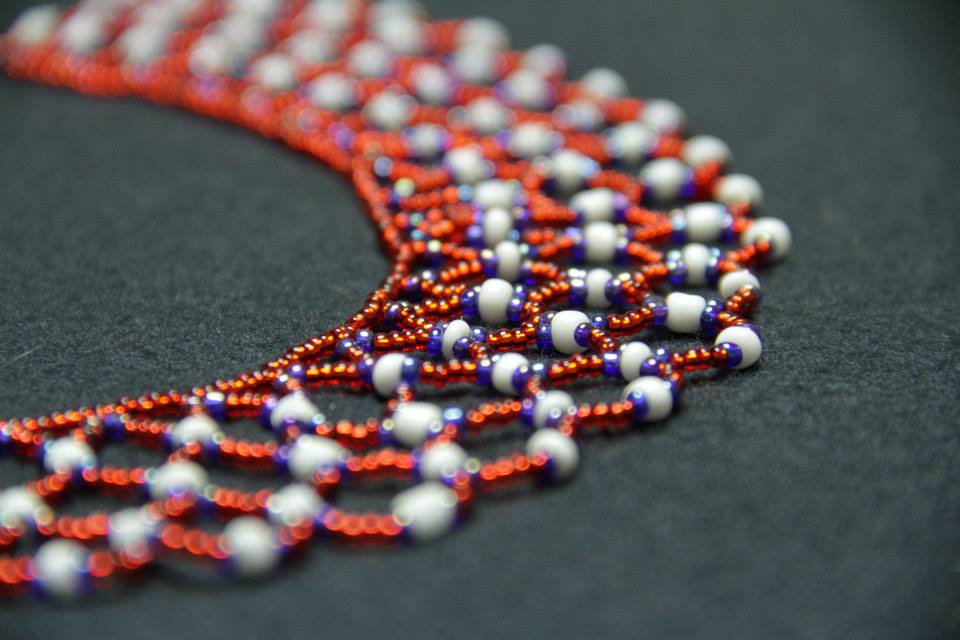In Egypt’s restive Sinai Peninsula, Bedouin tribes have inhabited the region for centuries sharing a distinct cultural tradition, bound by tribal alliances and family connections rather than state citizenship.
Over the last few decades, severe aridification has forced Bedouin tribes to give up their nomadic lifestyle in the mountains for a life as settlers on the coast. This change led men to take on new employment in the booming tourism sector whereas women lost their roles as sources of income, changing the power distribution within families. This dramatic lifestyle change paired with the sharp decline in tourism following the political upheavals in 2011 left Bedouin families struggling to make ends meet. Illiteracy rates are also high within the Bedouin community since they are not integrated into Egyptian society.
Traditionally, Bedouin women contributed to their families’ economic situation by herding sheep and goats and using the animals’ products to make food, clothing and handicrafts. Due to the decline in tourism, however, sales for these beautiful traditional handicrafts have dropped dramatically.
Badaweya, a women’s handicraft initiative in the region, now seeks to revive and empower Bedouin handicraft producers to start their own businesses, develop their products to meet modern economic needs and link them to markets within and beyond the Sinai region.

Founded in 2011, the organization also provides the women training in technical skills, design development and entrepreneurship in addition to providing information sessions on health topics peer-to-peer literacy education, and support with child care. Aiming to empower Bedouin women, support and develop the community and preserve centuries-old traditions, this unique initiative has enormous potential to be replicated in other parts of the Middle East and North African region to carry forward traditions through entrepreneurial projects.
This innovative initiative has also been selected as a finalist in the Women Powering Work: Innovations for Economic Equality in the MENA Region competition, launched by Ashoka Changemakers and GE. We had a chance to speak with Sherif El Ghamrawy, founder of Hemaya and co-founder of Badaweya, about the impact of their work:
Elan: Tell us a little about Badaweya initiative. How did it get started and what was the inspiration behind it?
Sherif El Ghamrawy: The idea of Badaweya was born in 2011, when the staff of local NGO, Hemaya, were reflecting together with Bedouin women on how we could improve their situation (the families are poor, women are restricted in movement and have few opportunities to earn money or pursue a higher education). The idea behind BADAWEYA was rooted in the fact that many of the older Bedouin women had already tried to sell simple crafts to tourists in the beach camps, but with limited success. The potential of the products was obvious, but it was also clear that there were many things that could be improved.
Our idea was to approach the situation in a market driven way and not focus solely on charity. We want to create sources of income for the women by training them in sewing and design, so that they can produce handicrafts that combine traditions with the demands of modern market, in terms of quality, functionality and design.
We also wanted them to get fair prices for their products and earn a workers income, between $110- 160 per month (an average family of 4-5 kids needs $150 to cover basic needs). We want to empower the women to become entrepreneurs. Therefore, we train them in setting up and managing small cooperatives. This helps ensure fair trade since the women can set prices by themselves. We also link them to suppliers, fair retailers and a variety of different markets and networks in bigger Egyptian cities, abroad, and via the internet. Therefore, they are able to flexibly react to changes on the market.
Our approach is holistic, too. We believe that a sustainable development can only take place, when the women are empowered to deal with all the problems that they are facing. In reaction to the demands of the participants, we also established a kindergarten, a system of peer teaching in literacy and classes in health education.
Elan: Why is this initiative crucial for women in Sinai?
SG: In the new settlements, different families live in close proximity. Traditions limit the women’s movement to the areas which are inhabited by their families. Younger and/or unmarried women are expected to stay at home. The situation has left the women with almost no opportunities to pursue a higher education or contribute to family income. However, older women enjoy more freedom.
With the sharp decline in tourism after the political upheavals, the Bedouin communities in Sinai are left without any income, for both men and women. The communities are struggling to deal with the new situation due to their lack of resources. They are not integrated into Egyptian society, illiteracy rates are high among men and women (approximately 50%) and only few have a higher education. For political reasons, the Sinai region has bad public infrastructure and tourism was the area’s main economic impetus.

The initiative can serve as a model for other communities in Sinai but also for traditional communities the MENA region in general. It focuses on the community’s unique abilities and teaches how to utilize them. It builds up capacity and resources so that beneficiaries become self-reliant. It also works in line with societal norms thereby allowing for sustainable development.
With respect to women, the initiative helps them to discover that they do have the power to put their own ideas of developing their community into action and are encouraged and supported to do so. Becoming breadwinners of the family, their position is re-invigorated and they get a sense of power to negotiate their own wishes with their family and in their community.
Elan: Tell us about the tradition of handicrafts in Bedouin culture in Sinai and how entrepreneurship helps move these traditions forward?
SG: Bedouin women have a long tradition of decorating garments and objects of everyday life, from sugar bags to camel saddles, with ornaments and patterns inspired by the nature of the mountains. This knowledge is transferred from the older to the younger women.
With adopting a new lifestyle, many products lost their function. Products that do not have a function in society tend to disappear. With the availability of ready-made garments for example, Bedouin women started to dress differently. In order to preserve traditional knowledge and design and to revive it, traditional handicrafts needed to regain an economic purpose.
 Entrepreneurship has positive effects on preserving local artistic traditions and on further developing them to be of use in modern life. In order to come up with handicraft designs that reflect the Sinai region, its people and rich history as well as cater to the demands of modern markets, the producer’s imagination is challenged. Within the initiative, the older women share their own experiences and stories while the younger women bring in their own innovation and new interpretations into the design process of the products which leads to intriguing results.
Entrepreneurship has positive effects on preserving local artistic traditions and on further developing them to be of use in modern life. In order to come up with handicraft designs that reflect the Sinai region, its people and rich history as well as cater to the demands of modern markets, the producer’s imagination is challenged. Within the initiative, the older women share their own experiences and stories while the younger women bring in their own innovation and new interpretations into the design process of the products which leads to intriguing results.
That way, traditional handicraft is not forgotten but regains its value and brings the community forward.
Elan: What are some of the barriers you have had to face with the launch of this initiative? How did you overcome them?
SG: Limitation in movement: Not all women of the village are allowed to attend trainings in the project house. BADAWEYA has developed two strategies to cope with this problem.
A system of small working groups was established where women who attended the trainings gather afterwards with others who couldn’t at a house that was accessible to all of them. BADAWEYA also opened up a second project location in a different part of the village to enable more women to benefit from trainings. Health awareness classes are also sometimes directly held in family houses.
Training: It was challenging to build trust between the women and the trainers who come and support them with technical skills. The key to win their trust was being transparent and including the women in all steps of the process, from deciding on the design for a product to how to calculate its price.
Involving men: We also try to get the men involved in BADAWEYA’s activities to ensure continuous acceptance in the community. At the moment, men take over tasks as drivers. We are also continuously exploring positions that they can fill in the future in logistics, transportation of material and products, etc, without taking away ownership from the women.
Elan: Why do you think entrepreneurship and economic equality is so important in the Middle East?
SG: Studies show that a higher percentage of working women has beneficial effects on a society. One reason for this is that working women tend to bring forward social issues in the society, such as family, health and education. The countries of the Middle East and North Africa (MENA) continue to have the world’s lowest participation rates of women in economic life. Cultural values allocate a high value to the women’s role as mother and housewife and do not favor women’s economic participation. In general, employers also prefer to hire men.

At the same time, most MENA countries are currently dealing with high rates of youth unemployment. The established structures cannot integrate the amount of young people that flock the labor market every year as a result of the demographics’ development.
For both groups, young people and women, entrepreneurship is a good way to enter the job market. MENA countries are in development and markets are not yet saturated with services and offers. There is a lot of space for innovation. Women in rural areas who are home confined can earn money in a culturally appropriate way by opening small self-employment initiatives for products that can be manufactured at home.
Elan: What advice would you give women who are seeking employment in the Sinai or the wider Middle East and North Africa?
SG: The advice depends on the women’s socio-economic background and their level of education. Women from rural areas with lower levels of education could set up microfinance projects or organize themselves in small cooperatives. Areas that offer possibilities to earn money are the further development of traditional handicrafts or agricultural/food products that can be manufactured with limited technological efforts.
In poorer suburban areas, innovative products or being niche suppliers could open new sources of income. Examples are initiatives that sell recycling products, e.g. garden furniture out of car tires. The middle class in bigger cities likes to purchase such innovative products.
Women with a high level of education should try to enter the private sector. Most MENA countries have already passed family friendly labor laws. They are, however, not being implemented. Women could organize themselves in networks to lobby for their interests.
Editor’s Note: Additional information about the competition, assessment criteria and fascinating trends that are emerging from the finalists’ solutions can be found at www.changemakers.com/
Follow #womenWork on Twitter to receive the latest on trends and competition news.




















[…] Badaweya Handicraft Initiative: Empowering women and reviving Bedouin traditions. January 7th, 2014. […]